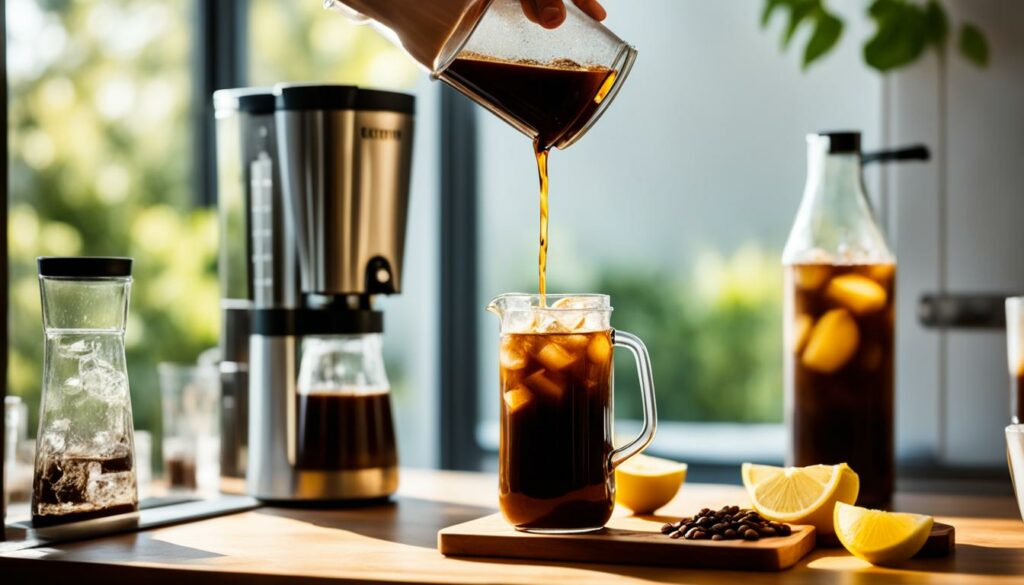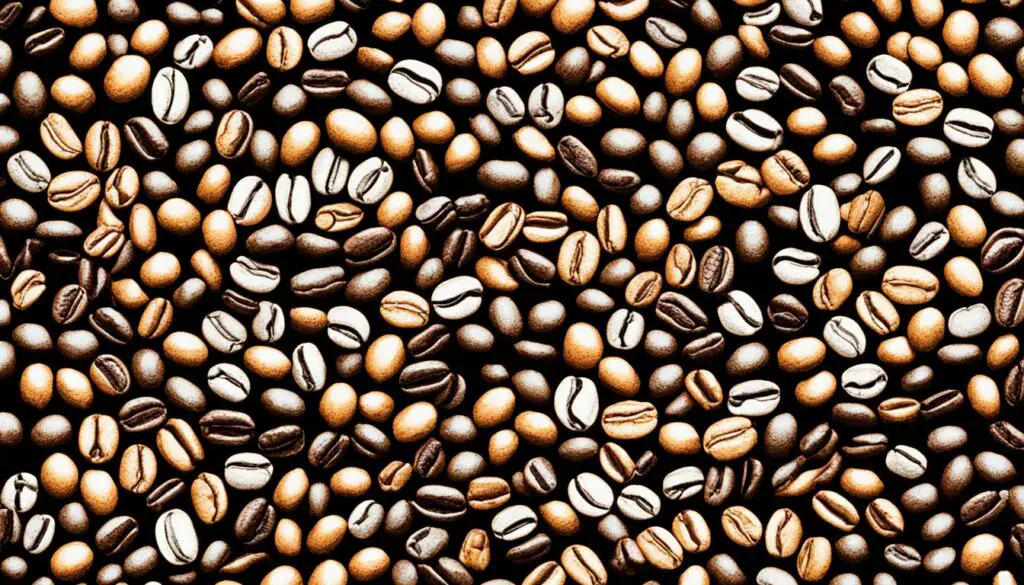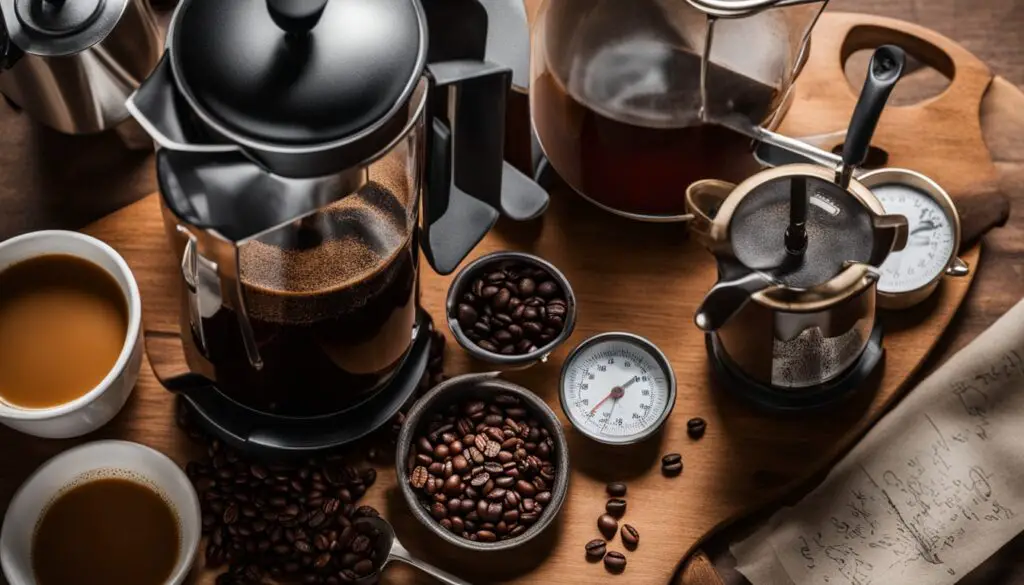Welcome to the cool world of cold brew coffee! Imagine it’s a hot summer day, and you’re chilling on your porch. The sunshine warms your skin and the smell of fresh coffee fills the air. You’re craving a tasty, cool drink. Cold brew is perfect for this.
Cold brew coffee is your go-to summer treat. It’s silky, full of flavor, and offers a gentle energy boost. It keeps you refreshed all day long. It’s the ideal choice for anyone who enjoys coffee or wants a new way to get their caffeine.
Making your own cold brew at home is super simple! You don’t need special gear or expert skills. We’ll give you straightforward advice on brewing that perfect batch.
We’ll start with the basics, like the science of cold brew. Then we’ll move on to choosing the best coffee beans and getting the water-coffee mix just right. You’ll learn about filtering, serving, and how to keep your cold brew fresh. We’ll even share ideas for customizing your cold brew and making it in different weather.
We’ve also talked to barista pros who shared their top tips. Their guidance will boost your brewing skills and make your cold brew even better.
So, whether you’re relaxing by the pool or need a cool sip on a hot day, cold brew coffee is your go-to. Let’s uncover the secrets of making this tasty drink at home. You’ll soon have the skills and knowledge to enjoy amazing cold brew anytime.
Introduction to Cold Brew Coffee
Cold brew coffee differs from the hot kind we usually drink. It’s made by soaking coffee grounds in cold water. This steeping process lasts for up to 24 hours.
The final drink is smoother and less bitter than hot coffee. Many people enjoy it over ice. Cold brew’s flavor is unique and can be tailored to different tastes.
Next, we’ll explore how cold brew works and share tips for making the best cup.
The Simple Science Behind Cold Brew
We’re going to dive into the science behind cold brew coffee. This knowledge will boost your brewing skills and make you value its unique taste even more.
Understanding the Cold Brew Process
Cold brew is made by soaking coarse coffee grounds in cold water. This happens for 12 to 24 hours. It makes a coffee concentrate that’s rich and smooth.
This method pulls out flavors slowly. It means the coffee is less acidic and bitter than usual. The result is a mellower taste.
Why Cold Brew Creates a Unique Flavor Profile
What makes cold brew taste different? Its slow process and lower temperature matter a lot. Cold water doesn’t pull out as many acidic or bitter parts from the beans.
Cold brew lets you taste the finer notes in the beans. The cool water and long soak bring out subtle flavors. This makes the coffee more interesting to taste.
The way cold brew is made keeps it fresh longer. The cool temperatures mean it doesn’t go stale fast. And, it draws out coffee oils and acids in a way that makes it taste smoother.
To sum up, cold brew has a unique and refreshing flavor. Its method of making, with cold water and time, creates a coffee that is smoother and less bitter.
Selecting Your Coffee Beans
The right coffee beans are vital for a great cold brew’s taste and scent. Here are a few pointers to pick the top coffee beans:
- Roast Level: Pick beans based on their roast to match what you like. Light roasts are lively and gentle, while dark roasts are bold and deep.
- Freshness: To get all the flavors right, choose the freshest beans. Always check for when they were roasted or the best by date.
- Origin: Where the beans come from affects their tastes. Beans from different places have flavors like fruity, nutty, or chocolatey.
- Variety: Try out various kinds of beans to see what you prefer. Varieties like Arabica or Robusta bring their own unique tastes and smells.
Considering these points while buying beans leads to a wonderful cold brew. It makes your coffee experience a joy.
The Perfect Water to Coffee Ratio
Getting the right water to coffee ratio is key for a tasty cold brew. Here are some simple tips to make it perfect each time. This ensures your cold brew turns out great.
Measuring for Precision
Being precise in measuring your coffee and water is very important. Use a kitchen scale for the coffee beans. The usual ratio for cold brew is 1:4, one part coffee to four parts water. Yet, you can change this to fit your likes.
For a stronger taste, add more coffee. For a lighter taste, use less coffee. The choice is yours.
It’s just as vital to measure your water well. A clear measuring cup or jug is great for this. Accuracy leads to a better taste in your cold brew.
Scaling Up Your Brew – Tips for Large Batches
Want to make more cold brew at once? You’ll need to adjust for great taste. Here’s how to do it:
- Adjust the coffee to water ratio: For bigger batches, change the coffee to water ratio. Try starting with more coffee, like 1:3 or 1:3.5, to keep the flavor right. Adjust as needed for your taste.
- Lengthen the steeping time: Steep your cold brew for longer with larger batches. Add 1-2 hours to the steeping time. This ensures the taste is just right.
- Stirring or agitation: Stirring your coffee grounds helps with even extraction in big batches. Do this once or twice while steeping, using a spoon or long utensil.
Follow these hints to scale up your cold brew. This way, you can enjoy plenty of your favorite summer drink.
Grinding Coffee Beans for Optimal Extraction
The grind size of your coffee beans is key for the perfect cold brew. It plays a big role in how your brew tastes. We’ll talk about why the size of your grind matters and help you pick the best grinder for cold brew.
Consistency Matters
A consistent grind size leads to great cold brew extraction. It decides how fast flavor gets into the water from the coffee. A constant grind gives a balanced taste without bitterness or being too weak.
For cold brew, use a coarser grind to keep it smooth and flavorful. This also lets it sit longer, pulling out the subtle notes in the beans.
Grind your beans to look like coarse sea salt. This lets water move freely through, making a tasty cold brew.
Choosing the Right Grinder
A good grinder is a must for consistent grounds and great cold brew. You can pick between manual and electric grinders.
Manual Grinders: They give you precise control over your grind and are easy to move around. They’re perfect for making a small amount of cold brew. Plus, they are usually less expensive than electric ones.
Electric Grinders: They are fast and convenient, ideal for big cold brew batches. With many grind settings, they help you achieve the right size easily.
Look for a grinder that lets you change the grind size and has quality burrs. Burr grinders do a better job at giving you a consistent grind.
Giving thought to your grinder choice and keeping your grind consistent will elevate your cold brew making.
Steeping Your Cold Brew
Steeping is key in the cold brew process. It lets the coffee grounds mix with water to extract flavor. To make great cold brew, nail the steeping time. Also, pick a good container for steeping.
Mastering the Steeping Time
The steeping time influences your cold brew’s taste. Short times make it milder, while longer times can up the strong, bold flavor. Try different times to find what you like best.
Tip: For a milder and less concentrated taste, you can start with a shorter steeping time, around 12 hours. If you prefer a stronger and bolder flavor, extend the steeping time up to 24 hours.
Container Choices for Steeping
Your steeping container affects taste and ease. Choices vary in design and function. Pick one based on what you prefer and what you have.
- Mason Jars: These are great for cold brew. Their wide top and clear sides help. They also hold a lot, making stirring and straining easy.
- Cold Brew Coffee Makers: These are handy for precise brewing. They have filters and some let you set the steeping time. This can control how strong your cold brew is.
- Pitchers or Carafes: A pitcher or carafe works if you don’t have a mason jar or maker. Make sure it seals well to keep the flavor in and bad smells out.
Note: Always choose a clean container. It should be odor-free to avoid bad-tasting cold brew.
Now, you’re set to brew cold coffee. You know the right steeping time and container to use. Let’s move on to the next steps.
Filtration Techniques for a Clearer Brew
Filtration is key to a sediment-free cold brew. It removes coffee bits for a smooth drink. We’ll look at ways and tools for crystal clear cold brew.
Fine mesh sieves are great for this. They let the liquid pass but catch the tiny particles. To use, just pour your brew through the sieve into another container.
Another way is with coffee filters. Place a filter in a funnel or brewer and pour your cold brew. The filter stops sediments, giving you a clean taste. Use good filters for the best result.
For those wanting to be green, try nut milk bags. They’re made for straining and great at it. Put your brew in, close, and gently press to get a clear drink.
| Filtration Technique | Tool | Advantages |
|---|---|---|
| Fine Mesh Sieves | A fine mesh sieve | – Easy to use – Captures small particles – Quick filtration |
| Coffee Filters | A funnel or drip coffee maker with a coffee filter | – Widely available – Convenient to use – Removes sediments effectively |
| Nut Milk Bags | A reusable nut milk bag | – Eco-friendly option – Reusable – Efficient filtration |
Trying these methods helps find your favorite for clear, delicious cold brew. Enjoy the pure taste and smoothness of your perfectly filtered drink!
Serving and Storing Your Cold Brew
Making the perfect cold brew is half the battle. Knowing the best ways to serve and store it is equally as important. This section will cover how to store your cold brew for the best taste. We’ll look at the right storage containers and how to keep your cold brew fresh. Also, we’ll give tips on serving your cold brew in fun and tasty ways.
Best Practices for Storage
How you store your cold brew really matters. Here’s what you can do to keep it tasting great:
- Put it in an airtight container to keep out oxygen and moisture.
- Keep it in the fridge to slow down how fast it changes. Drink it within 3-4 days to enjoy it the most.
- Avoid odorous foods when storing cold brew, as it can pick up their smells easily.
- To stay fresh, split a big batch into smaller parts. This makes sure you open one at a time while the rest stays sealed.
Creative Serving Suggestions
Cold brew is great because there are so many ways to serve it. Try these ideas to make your cold brew even better:
- Use flavored ice cubes to boost the taste of your drink.
- Test out different types of milk, like almond or coconut milk, for flavor twists.
- Mix your cold brew with ice cream or frozen fruit for a unique drink.
- Add syrups, spices, or extracts to make your cold brew sweet or flavorful.
- Top your drink with herbs, citrus zest, or cocoa powder to make it look special.
By storing your cold brew correctly and serving it in fun ways, you’ll get the most out of it. Enjoy every sip and treat your taste buds.

Customizing Your Cold Brew
Cold brew coffee is great because you can make it your own. You can adjust it to fit your own flavor likes. Let’s explore how you can make your cold brew unique in this part.
Add-Ins for Enhanced Flavor
Improving your cold brew doesn’t take much. Just add some special ingredients to enrich its taste. Check out these suggestions to make your cold brew even tastier:
- Syrups: Try out vanilla, caramel, or hazelnut syrups for sweetness and a richer flavor.
- Spices: Use cinnamon, nutmeg, or cardamom to add warm and fragrant hints to your coffee. They go really well together.
- Extracts: Use almond, mint, or coconut extracts for fresh and unique cold brew flavors.
Non-Dairy Alternatives for a Vegan Option
If you’re vegan or trying to eat less dairy, there are many non-dairy milks to choose from for your cold brew:
- Almond Milk: Almond milk is creamy and adds a nutty taste. Pick unsweetened kinds for a more even flavor.
- Coconut Milk: Coconut milk is creamy and a bit sweet, giving your coffee a tropical flair. It’s great with flavored syrups too.
- Oat Milk: Oat milk’s earthy taste complements cold brew’s smoothness. Plus, it’s perfect for those avoiding nuts.
You can stick with the classic or try new things with your cold brew. Whether flavors or milk choices, the sky’s the limit. Let your creativity flow and see what cold brew you can come up with.
Tips for Making Cold Brew in Different Climates
Cold brew coffee is loved globally, but making it in various climates can be tricky. If you’re in a hot, humid place or a cold, dry one, we can help. We’ll talk about temperature tweaks, how long to brew, and where to keep your cold brew perfect. Let’s make sure your cold brew turns out great, no matter where you are.
For those in steamy and warm spots, higher heat and wetness are key factors. Below are tips on handling these conditions:
- Shorten the brewing time a bit to avoid making it too strong in hot weather
- Keep your cold brew in a fridge or a cool area to keep it fresh and safe
- Use a coarser grind to stop filters from getting stuck due to damp air
- Try more coffee grounds to balance out a quicker brew in heat
Now, moving to cold, arid places, we’ve got tips for you too:
- Make the brewing time longer for slower extraction when it’s cold
- Keep your cold brew sealed in airtight containers to shield it from bad smells in the dry air
- Choose a finer grind to help with brewing in chilly conditions
- Warm up your brewing stuff and cups ahead to keep the cold out
These guidelines are here to tweak your cold brew in any climate. Everyone has their likes, but feel free to play around. Making small changes can lead to your perfect cold brew.
Cold Brew Coffee Tips from Barista Experts
We’re diving into the world of cold brew with insights from barista pros. They’re sharing their secret tips and techniques. You’ll learn how to make your cold brew better and wow everyone.
Conclusion
To make the best cold brew coffee, you need to know a bit of science. Pick top-notch coffee beans and get the right water to coffee mix. Use the tips here to make a yummy, chilled summer drink that fits what you like.
Cold brew coffee is very versatile. You can go for the classic black cold brew or mix it up with flavors and toppings. Getting creative is key to making your cold brew stand out.
Enjoy making cold brew as much as drinking it. It’s a skill that gets better with practice. Love the journey and celebrate making that perfect cup.
Get your coffee beans ready and set up your brewing gear. It’s time to enjoy a cool quest with cold brew. You now have what it takes to make great cold brew all summer. Here’s to the fun of making and sharing cold brew coffee!
FAQ
What is cold brew coffee?
Cold brew coffee is made by soaking coffee grounds in cold water for a long time. Usually, it sits for 12 to 24 hours. This method creates a drink that’s smooth, gentle on the stomach, and not too bitter, perfect for sipping cold.
How does cold brew differ from traditional hot brewed coffee?
Unlike hot coffee, cold brew is smoother and has less bite. It gets its unique taste from its slow, cold-water brewing process. It’s enjoyed cold, which is great for the summer months.
What are the key factors to consider when selecting coffee beans for cold brew?
Picking the right beans is crucial. Think about roast type, where they came from, and if they’re fresh. All roast levels can be used, but the taste will change. Fresh, high-quality beans will make your cold brew taste even better.
What is the ideal water to coffee ratio for cold brew?
Normally, you’d use one cup of coffee grounds to four cups of water. But, you can change this to suit how strong or mild you like your brew.
What is the recommended grind size for cold brew?
A coarse grind size is best for cold brew. Consistency in grind size is key for taste consistency. A good grinder, either manual or electric, can get this right for you.
How long should I steep my cold brew?
Steeping for 12 to 24 hours is common but you can change it up to adjust the taste. Trying different steep times lets you find your favorite flavor.
What are the recommended filtration techniques for cold brew?
Choose between fine mesh sieves, coffee filters, or nut milk bags to filter your brew. Each method has its benefits, so pick the one that seems easiest to use for you.
How should I store my cold brew?
Store your cold brew in airtight containers in the fridge to keep it fresh. This wards off flavor changes. It’s best to drink it within a few days of making it.
How can I customize my cold brew?
You can get creative with cold brew. Add your favorite syrups, spices, or extracts for a unique taste. There are also many non-dairy options if you prefer.
What tips can you provide for making cold brew in different climates?
In hot and wet places, try a shorter brewing time to avoid strong flavors. For cold, dry climates, consider steeping longer to get a richer taste.
What advice do barista experts have for making cold brew coffee?
Top baristas suggest trying different methods and flavors to find what you love. They stress the use of quality beans and tools for the best cold brew experience.












